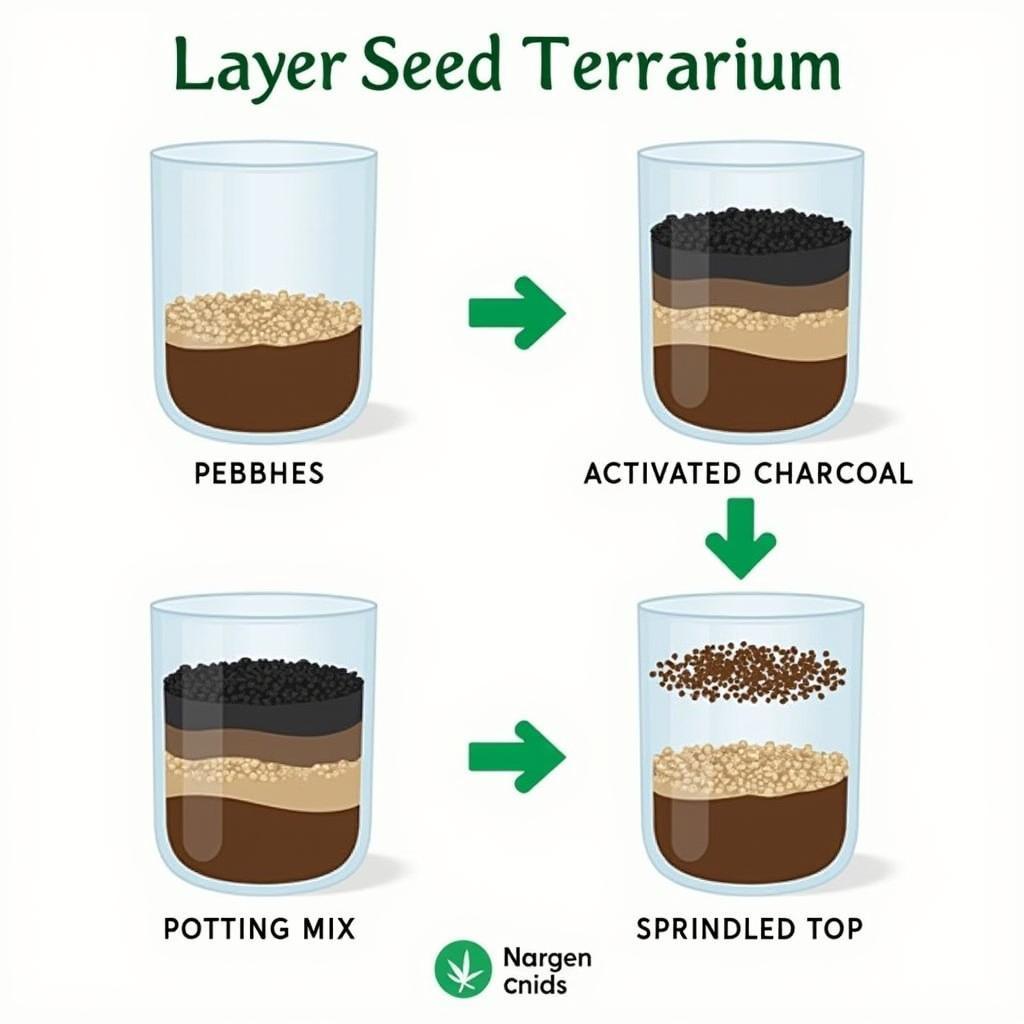Creating a Seed Terrarium: A Step-by-Step Guide
November 13, 2024Seed Terrariums offer a captivating glimpse into the miniature world of plant life, showcasing the beauty of nature within a controlled environment. They are a fascinating way to witness the magic of germination and growth, perfect for both experienced gardeners and enthusiastic beginners. Whether you’re looking for a unique decorative piece or a hands-on educational project, building a seed terrarium can be a rewarding and enjoyable experience.
What is a Seed Terrarium?
A seed terrarium is a sealed or open glass container that creates a self-sustaining environment for seeds to germinate and grow. The closed environment traps moisture and heat, mimicking the natural conditions necessary for seed growth. This makes them relatively low-maintenance, requiring minimal watering once established. They are an excellent choice for those who may not have a green thumb or much space for traditional gardening. Seed terrariums are also a fantastic educational tool, providing a visual representation of the plant life cycle.
Choosing the Right Seeds for Your Terrarium
Selecting the right seeds is crucial for a successful seed terrarium. Opt for small, slow-growing varieties that thrive in humid environments. Some popular choices include:
- Moss spores: These tiny spores create a lush, green carpet within your terrarium.
- Fern spores: Similar to moss, ferns offer a delicate and vibrant green addition.
- Carnivorous plant seeds: For a more exotic touch, consider carnivorous plant seeds like sundews or Venus flytraps.
- Herb seeds: Small herb seeds like thyme or oregano can add a fragrant dimension to your terrarium.
- Flower seeds: Choose small flowering plants like Baby’s Breath or African Violets for a pop of color.
Gathering Your Materials
Before you begin, gather all the necessary materials for your seed terrarium:
- A clear glass container with a lid or opening.
- Potting mix specifically designed for terrariums.
- Activated charcoal.
- Pebbles or small rocks.
- Spritzer bottle filled with water.
- Your chosen seeds.
- Optional: Decorative elements like small figurines or moss.
Building Your Seed Terrarium: A Step-by-Step Guide
Follow these simple steps to create your own thriving seed terrarium:
- Layer the Drainage: Start by adding a layer of pebbles or small rocks to the bottom of your container. This provides drainage and prevents the roots from sitting in water.
- Add Activated Charcoal: Sprinkle a thin layer of activated charcoal over the pebbles. This helps to filter the air and prevent mold growth.
- Potting Mix: Add a layer of terrarium potting mix on top of the charcoal. The depth of the potting mix will depend on the size of your container and the type of plants you are growing.
- Sowing the Seeds: Scatter your chosen seeds evenly over the surface of the potting mix. Gently press them into the soil, but don’t bury them too deep.
- Watering: Lightly mist the soil with water using a spritzer bottle. The soil should be moist but not soggy.
- Sealing (Optional): If you are creating a closed terrarium, seal the lid tightly. Open terrariums don’t require a lid but may need more frequent watering.
- Placement: Place your seed terrarium in a location with indirect sunlight. Avoid direct sunlight, as this can overheat the terrarium and damage the plants.
 Layering the materials for your seed terrarium is essential for proper drainage and growth.
Layering the materials for your seed terrarium is essential for proper drainage and growth.
“Seed terrariums are a fantastic way to bring the beauty of nature indoors. They require minimal maintenance and can thrive in even the smallest spaces,” says expert botanist Dr. Emily Carter from the Royal Botanic Gardens, Kew.
Maintaining Your Seed Terrarium
Once your seed terrarium is established, it requires minimal maintenance. Monitor the moisture levels and mist the soil when it begins to dry out. Open terrariums may need more frequent watering than closed terrariums. Avoid overwatering, as this can lead to mold growth.
“With a little care and attention, your seed terrarium can flourish and provide you with a miniature ecosystem to enjoy for years to come,” adds renowned horticulturalist Mr. James Green, author of “The Terrarium Handbook”.
Conclusion
Seed terrariums offer a captivating and low-maintenance way to experience the wonder of plant life. By following these simple steps, you can create your own thriving miniature ecosystem and bring a touch of nature into your home or office. So, start your seed terrarium journey today and witness the magic of growth unfold before your eyes!
FAQ
- How often should I water my seed terrarium?
- What type of light is best for a seed terrarium?
- Can I use any type of glass container?
- What should I do if mold starts to grow in my terrarium?
- How long does it take for seeds to germinate in a terrarium?
- What are some common mistakes to avoid when making a seed terrarium?
- Where can I find more information on creating and maintaining seed terrariums?
Do you have more questions about seed terrariums, carnivorous plants or other miniature gardens? Explore more helpful articles on our website.
When you need assistance, please contact Phone Number: 0915117113, Email: [email protected] Or visit us at: Group 3, Binh An Hamlet, Phu Thuong, Vietnam, Binh Phuoc 830000, Vietnam. We have a 24/7 customer service team.